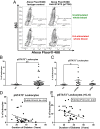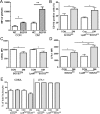STAT3 activation in circulating myeloid-derived cells contributes to retinal microvascular dysfunction in diabetes
- PMID: 31286987
- PMCID: PMC6615157
- DOI: 10.1186/s12974-019-1533-1
STAT3 activation in circulating myeloid-derived cells contributes to retinal microvascular dysfunction in diabetes
Abstract
Background: Leukostasis is a key patho-physiological event responsible for capillary occlusion in diabetic retinopathy. Circulating monocytes are the main cell type entrapped in retinal vessels in diabetes. In this study, we investigated the role of the signal transducer and activator of transcription 3 (STAT3) pathway in diabetes-induced immune cell activation and its contribution to retinal microvascular degeneration.
Methods: Forty-one patients with type 1 diabetes (T1D) [mild non-proliferative diabetic retinopathy (mNPDR) (n = 13), active proliferative DR (aPDR) (n = 14), inactive PDR (iPDR) (n = 14)] and 13 age- and gender-matched healthy controls were recruited to the study. C57BL/6 J WT mice, SOCS3fl/fl and LysMCre/+SOCS3fl/fl mice were rendered diabetic by Streptozotocin injection. The expression of the phosphorylated human and mouse STAT3 (pSTAT3), mouse LFA-1, CD62L, CD11b and MHC-II in circulating immune cells was evaluated by flow cytometry. The expression of suppressor of cytokine signalling 3 (SOCS3) was examined by real-time RT-PCR. Mouse plasma levels of cytokines were measured by Cytometric Beads Array assay. Retinal leukostasis was examined following FITC-Concanavalin A perfusion and acellular capillary was examined following Isolectin B4 and Collagen IV staining.
Results: Compared to healthy controls, the expression of pSTAT3 in circulating leukocytes was statistically significantly higher in mNPDR but not aPDR and was negatively correlated with diabetes duration. The expression of pSTAT3 and its inhibitor SOCS3 was also significantly increased in leukocytes from diabetic mice. Diabetic mice had higher plasma levels of IL6 and CCL2 compared with control mice. LysMCre/+SOCS3fl/fl mice and SOCS3fl/fl mice developed comparative levels of diabetes, but leukocyte activation, retinal leukostasis and number of acellular capillaries were statistically significantly increased in LysMCre/+SOCS3fl/fl diabetic mice.
Conclusion: STAT3 activation in circulating immune cells appears to contribute to retinal microvascular degeneration and may be involved in DR initiation in T1D.
Keywords: Diabetic retinopathy; Inflammation; Monocytes; SOCS3.
Conflict of interest statement
The authors declare that they have no competing interests.
Figures





References
-
- Xu H, Chen M. Diabetic retinopathy and dysregulated innate immunity. Vis Res. 2017;139:39–46. - PubMed
-
- Xu H, Chen M, Forrester JV. Para-inflammation in the aging retina. Prog Retin Eye Res. 2009;28(5):348–368. - PubMed
-
- Miyake K, Kaisho T. Homeostatic inflammation in innate immunity. Curr Opin Immunol. 2014;30:85–90. - PubMed
MeSH terms
Substances
LinkOut - more resources
Full Text Sources
Medical
Research Materials
Miscellaneous

